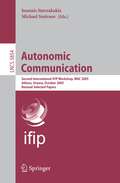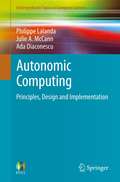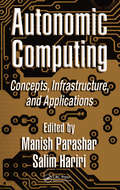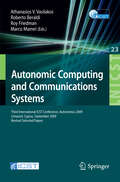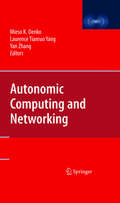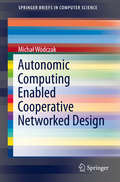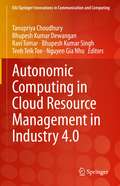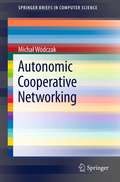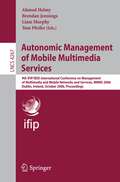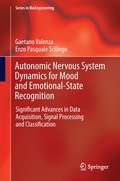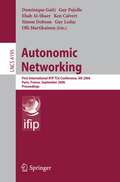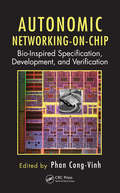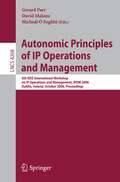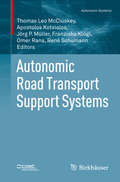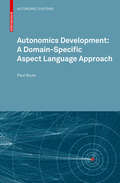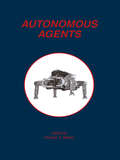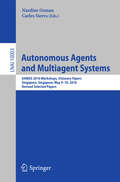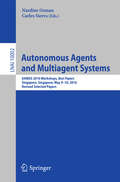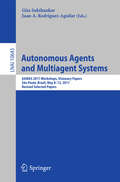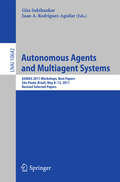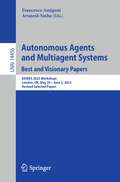- Table View
- List View
Autonomic Communication (Lecture Notes In Physics #Vol. 51)
by Stamatis Karnouskos Manish Parashar Witold Pedrycz Athanasios V. VasilakosNew paradigms for communication/networking systems are needed in order to tackle the emerging issues such as heterogeneity, complexity and management of evolvable infrastructures. In order to realize such advanced systems, approaches should become task- and knowledge-driven, enabling a service-oriented, requirement, and trust-driven development of communication networks. The networking and seamless integration of concepts, technologies and devices in a dynamically changing environment poses many challenges to the research community, including interoperability, programmability, management, openness, reliability, performance, context awareness, intelligence, autonomy, security, privacy, safety, and semantics. This edited volume explores the challenges of technologies to realize the vision where devices and applications seamlessly interconnect, intelligently cooperate, and autonomously manage themselves, and as a result, the borders of virtual and real world vanish or become significantly blurred.
Autonomic Communication: First International IFIP Workshop, WAC 2004, Berlin, Germany, October 18-19, 2004, Revised Selected Papers (Lecture Notes in Computer Science #3457)
by Michael SmirnovThe ?rst IFIP Workshop on Autonomic Communication (WAC 2004) was held 18–19 October 2004 in Berlin, Germany. The workshop was organized by Fra- hofer FOKUS with the help of partners of the EU-funded Autonomic Com- nication Coordination Action — IST-6475 (ACCA), and under technical sp- sorship of IFIP WG6. 6 — Management of Networks and Distributed Systems. The purpose of this workshop was to discuss Autonomic Communication—a new communication paradigm to assist the design of the next-generation n- works. WAC 2004 was explicitly focused on the principles that help to achieve purposeful behavior on top of self-organization (self-management, self-healing, self-awareness, etc. ). The workshop intended to derive these common principles from submissions that study network element’s autonomic behavior exposed by innovative (cross-layer optimized, context-aware, and securely programmable) protocol stack (or its middleware emulations) in its interaction with numerous, often dynamic network groups and communities. The goals were to understand how autonomic behaviors are learned, in?uenced or changed, and how, in turn, these a?ect other elements, groups and the network. The highly interactive and exploratory nature of WAC 2004 de?ned its format — six main sessions grouped in three blocks, each block followed by a panel with all speakers of the previous block as panellists and session chairs as panel moderators. The?rstpanelaimedtohighlightthemainprinciplesguidingresearchinal- rithms,protocolsandmiddleware;thesecondpanelinvestigatedgrandchallenges of network and service composition; the third panel had to answer the question “HowDoestheAutonomicNetworkInteractwiththeKnowledgePlane?”. Panel reports were compiled by panel moderators and conclude this volume.
Autonomic Communication: Second International IFIP Workshop, WAC 2005, Athens, Greece, October 2-5, 2005, Revised Selected Papers (Lecture Notes in Computer Science #3854)
by Ioannis Stavrakakis Michael SmirnovThis book constitutes the thoroughly refereed post-proceedings of the Second International IFIP Workshop on Autonomic Communication, WAC 2005, held in Athens, Greece in October 2005. The 22 revised full papers presented together with one keynote paper, three invited papers and two panel summaries were carefully selected during two rounds of reviewing and improvement from numerous submissions. The papers discuss the principles of Autonomic Communication (AC).
Autonomic Computing: Principles, Design and Implementation (Undergraduate Topics in Computer Science)
by Philippe Lalanda Julie A. McCann Ada DiaconescuThis textbook provides a practical perspective on autonomic computing. Through the combined use of examples and hands-on projects, the book enables the reader to rapidly gain an understanding of the theories, models, design principles and challenges of this subject while building upon their current knowledge. Features: provides a structured and comprehensive introduction to autonomic computing with a software engineering perspective; supported by a downloadable learning environment and source code that allows students to develop, execute, and test autonomic applications at an associated website; presents the latest information on techniques implementing self-monitoring, self-knowledge, decision-making and self-adaptation; discusses the challenges to evaluating an autonomic system, aiding the reader in designing tests and metrics that can be used to compare systems; reviews the most relevant sources of inspiration for autonomic computing, with pointers towards more extensive specialty literature.
Autonomic Computing: Concepts, Infrastructure, and Applications
by Manish Parashar and Salim HaririThe complexity of modern computer networks and systems, combined with the extremely dynamic environments in which they operate, is beginning to outpace our ability to manage them. Taking yet another page from the biomimetics playbook, the autonomic computing paradigm mimics the human autonomic nervous system to free system developers and administrators from performing and overseeing low-level tasks. Surveying the current path toward this paradigm, Autonomic Computing: Concepts, Infrastructure, and Applications offers a comprehensive overview of state-of-the-art research and implementations in this emerging area.This book begins by introducing the concepts and requirements of autonomic computing and exploring the architectures required to implement such a system. The focus then shifts to the approaches and infrastructures, including control-based and recipe-based concepts, followed by enabling systems, technologies, and services proposed for achieving a set of "self-*" properties, including self-configuration, self-healing, self-optimization, and self-protection. In the final section, examples of real-world implementations reflect the potential of emerging autonomic systems, such as dynamic server allocation and runtime reconfiguration and repair.Collecting cutting-edge work and perspectives from leading experts, Autonomic Computing: Concepts, Infrastructure, and Applications reveals the progress made and outlines the future challenges still facing this exciting and dynamic field.
Autonomic Computing: Concepts, Infrastructure, and Applications
by Manish Parashar Salim HaririThe complexity of modern computer networks and systems, combined with the extremely dynamic environments in which they operate, is beginning to outpace our ability to manage them. Taking yet another page from the biomimetics playbook, the autonomic computing paradigm mimics the human autonomic nervous system to free system developers and administrators from performing and overseeing low-level tasks. Surveying the current path toward this paradigm, Autonomic Computing: Concepts, Infrastructure, and Applications offers a comprehensive overview of state-of-the-art research and implementations in this emerging area.This book begins by introducing the concepts and requirements of autonomic computing and exploring the architectures required to implement such a system. The focus then shifts to the approaches and infrastructures, including control-based and recipe-based concepts, followed by enabling systems, technologies, and services proposed for achieving a set of "self-*" properties, including self-configuration, self-healing, self-optimization, and self-protection. In the final section, examples of real-world implementations reflect the potential of emerging autonomic systems, such as dynamic server allocation and runtime reconfiguration and repair.Collecting cutting-edge work and perspectives from leading experts, Autonomic Computing: Concepts, Infrastructure, and Applications reveals the progress made and outlines the future challenges still facing this exciting and dynamic field.
Autonomic Computing and Communications Systems: Third International ICST Conference, Autonomics 2009, Limassol, Cyprus, September 9-11, 2009, Revised Selected Papers (Lecture Notes of the Institute for Computer Sciences, Social Informatics and Telecommunications Engineering #23)
by Athanasios V. Vasilakos Roberto Beraldi Roy Friedman Marco MameiThese proceedings contain the papers presented at the Third International ICST C- ference on Autonomic Computing and Communication Systems, Autonomics 2009, held at the Cyprus University of Technology, Limassol, Cyprus, during September 9–11, 2009. As for the previous editions of the conference, this year too the primary goal of the event was to allow people working in the areas of communication, design, progr- ming, use and fundamental limits of autonomics pervasive systems to meet and - change their ideas and experiences in the aforementioned issues. In maintaining the tradition of excellence of Autonomics, this year we accepted 11 high-quality papers out of 26 submitted and had 5 invited talks, covering various aspects of autonomic computing including applications, middleware, networking protocols, and evaluation. The wide interest in the autonomic systems is shown by the broad range of topics covered in the papers presented at the conference. All papers presented at the conf- ence are published here and some of them, which are considered particularly intere- ing, will be considered for publication in a special issue of the International Journal of Autonomics and Adaptive Communications Systems (IJAACS). The conference also hosted the First International Workshop on Agent-Based Social Simulation and Au- nomic Systems (ABSS@AS).
Autonomic Computing and Networking
by Mieso Denko Laurence Tianruo Yang Yan ZhangAutonomic Computing and Networking presents introductory and advanced topics on autonomic computing and networking with emphasis on architectures, protocols, services, privacy & security, simulation and implementation testbeds. Autonomic computing and networking are new computing and networking paradigms that allow the creation of self-managing and self-controlling computing and networking environment using techniques such as distributed algorithms and context-awareness to dynamically control networking functions without human interventions. Autonomic networking is characterized by recovery from failures and malfunctions, agility to changing networking environment, self-optimization and self-awareness. The self-control and management features can help to overcome the growing complexity and heterogeneity of exiting communication networks and systems. The realization of fully autonomic heterogeneous networking introduces several research challenges in all aspects of computing and networking and related fields.
Autonomic Computing Enabled Cooperative Networked Design (SpringerBriefs in Computer Science)
by Michał WódczakThis book introduces the concept of autonomic computing driven cooperative networked system design from an architectural perspective. As such it leverages and capitalises on the relevant advancements in both the realms of autonomic computing and networking by welding them closely together. In particular, a multi-faceted Autonomic Cooperative System Architectural Model is defined which incorporates the notion of Autonomic Cooperative Behaviour being orchestrated by the Autonomic Cooperative Networking Protocol of a cross-layer nature. The overall proposed solution not only advocates for the inclusion of certain Decision Making Entities, but it also provides all the necessary implementation guidelines along with the pertinent standardisation orientated insight.
Autonomic Computing in Cloud Resource Management in Industry 4.0 (EAI/Springer Innovations in Communication and Computing)
by Tanupriya Choudhury Bhupesh Kumar Dewangan Ravi Tomar Bhupesh Kumar Singh Teoh Teik Toe Nguyen Gia NhuThis book describes the next generation of industry—Industry 4.0—and how it holds the promise of increased flexibility in manufacturing, along with automation, better quality, and improved productivity. The authors discuss how it thus enables companies to cope with the challenges of producing increasingly individualized products with a short lead-time to market and higher quality. The authors posit that intelligent cloud services and resource sharing play an important role in Industry 4.0 anticipated Fourth Industrial Revolution. This book serves the different issues and challenges in cloud resource management CRM techniques with proper propped solution for IT organizations. The book features chapters based on the characteristics of autonomic computing with its applicability in CRM. Each chapter features the techniques and analysis of each mechanism to make better resource management in cloud.
Autonomic Cooperative Networking (SpringerBriefs in Computer Science)
by Michał WódczakCooperative transmission aims to improve the reliability of wireless mobile communications through the use of diversity provided by additional relays assisting in the transmission between the source and destination nodes. This is possible as the rationale behind spatio-temporal processing can be easily mapped onto networked systems. Autonomic Cooperative Networking studies the further evolution of this phenomenon by first involving the network layer routines and then additionally incorporating the notion of autonomic system design.
Autonomic Management of Mobile Multimedia Services: 9th IFIP/IEEE International Conference on Management of Multimedia and Mobile Networks and Services, MMNS 2006, Dublin, Ireland, October 25-27, 2006, Proceedings (Lecture Notes in Computer Science #4267)
by Ahmed Helmy Brendan Jennings Liam Murphy Tom PfeiferThis book constitutes the refereed proceedings of the 9th IFIP/IEEE International Conference on Management of Multimedia and Mobile Networks and Services, MMNS 2006, held in Dublin, Ireland in October 2006 in the course of the 2nd International Week on Management of Networks and Services, Manweek 2006. The 18 revised full papers and six revised short papers presented were carefully reviewed and selected from 71 submissions.
Autonomic Nervous System Dynamics for Mood and Emotional-State Recognition: Significant Advances in Data Acquisition, Signal Processing and Classification (Series in BioEngineering)
by Gaetano Valenza Enzo Pasquale ScilingoThis monograph reports on advances in the measurement and study of autonomic nervous system (ANS) dynamics as a source of reliable and effective markers for mood state recognition and assessment of emotional responses. Its primary impact will be in affective computing and the application of emotion-recognition systems. Applicative studies of biosignals such as: electrocardiograms; electrodermal responses; respiration activity; gaze points; and pupil-size variation are covered in detail, and experimental results explain how to characterize the elicited affective levels and mood states pragmatically and accurately using the information thus extracted from the ANS. Nonlinear signal processing techniques play a crucial role in understanding the ANS physiology underlying superficially noticeable changes and provide important quantifiers of cardiovascular control dynamics. These have prognostic value in both healthy subjects and patients with mood disorders. Moreover, Autonomic Nervous System Dynamics for Mood and Emotional-State Recognition proposes a novel probabilistic approach based on the point-process theory in order to model and characterize the instantaneous ANS nonlinear dynamics providing a foundation from which machine “understanding” of emotional response can be enhanced. Using mathematics and signal processing, this work also contributes to pragmatic issues such as emotional and mood-state modeling, elicitation, and non-invasive ANS monitoring. Throughout the text a critical review on the current state-of-the-art is reported, leading to the description of dedicated experimental protocols, novel and reliable mood models, and novel wearable systems able to perform ANS monitoring in a naturalistic environment. Biomedical engineers will find this book of interest, especially those concerned with nonlinear analysis, as will researchers and industrial technicians developing wearable systems and sensors for ANS monitoring.
Autonomic Networking: First International IFIP TC6 Conference, AN 2006, Paris, France, September 27-29, 2006, Proceedings (Lecture Notes in Computer Science #4195)
by Guy Pujolle Ehab Al-Shaer Ken Calvert Simon Dobson Guy Leduc Martikainen Dominique GaitiThis book constitutes the refereed proceedings of the First International IFIP TC6 Conference on Autonomic Networking, AN 2006. The 24 revised full papers presented were carefully reviewed and selected for inclusion in the book. The papers are organized in topical sections on autonomic networks, self-configuration, autonomic platform and services, autonomic management and discovery policy-based management, ad hoc, sensor and ambient autonomic networks, and autonomic control of mobile networks.
Autonomic Networking-on-Chip: Bio-Inspired Specification, Development, and Verification (Embedded Multi-Core Systems)
by Phan Cong-VinhDespite the growing mainstream importance and unique advantages of autonomic networking-on-chip (ANoC) technology, Autonomic Networking-On-Chip: Bio-Inspired Specification, Development, and Verification is among the first books to evaluate research results on formalizing this emerging NoC paradigm, which was inspired by the human nervous system. The FIRST Book to Assess Research Results, Opportunities, & Trends in "BioChipNets" The third book in the Embedded Multi-Core Systems series from CRC Press, this is an advanced technical guide and reference composed of contributions from prominent researchers in industry and academia around the world. A response to the critical need for a global information exchange and dialogue, it is written for engineers, scientists, practitioners, and other researchers who have a basic understanding of NoC and are now ready to learn how to specify, develop, and verify ANoC using rigorous approaches. Offers Expert Insights Into Technical Topics Including: Bio-inspired NoC How to map applications onto ANoC ANoC for FPGAs and structured ASICs Methods to apply formal methods in ANoC development Ways to formalize languages that enable ANoC Methods to validate and verify techniques for ANoC Use of "self-" processes in ANoC (self-organization, configuration, healing, optimization, protection, etc.) Use of calculi for reasoning about context awareness and programming models in ANoC With illustrative figures to simplify contents and enhance understanding, this resource contains original, peer-reviewed chapters reporting on new developments and opportunities, emerging trends, and open research problems of interest to both the autonomic computing and network-on-chip communities. Coverage includes state-of-the-art ANoC architectures, protocols, technologies, and applications. This volume thoroughly explores the theory behind ANoC to illustrate strategies that enable readers to use formal ANoC methods yet still make sound judgments and allow for reasonable justifications in practice.
Autonomic Networking-on-Chip: Bio-Inspired Specification, Development, and Verification (Embedded Multi-Core Systems)
by Phan Cong-VinhDespite the growing mainstream importance and unique advantages of autonomic networking-on-chip (ANoC) technology, Autonomic Networking-On-Chip: Bio-Inspired Specification, Development, and Verification is among the first books to evaluate research results on formalizing this emerging NoC paradigm, which was inspired by the human nervous system. The FIRST Book to Assess Research Results, Opportunities, & Trends in "BioChipNets" The third book in the Embedded Multi-Core Systems series from CRC Press, this is an advanced technical guide and reference composed of contributions from prominent researchers in industry and academia around the world. A response to the critical need for a global information exchange and dialogue, it is written for engineers, scientists, practitioners, and other researchers who have a basic understanding of NoC and are now ready to learn how to specify, develop, and verify ANoC using rigorous approaches. Offers Expert Insights Into Technical Topics Including: Bio-inspired NoC How to map applications onto ANoC ANoC for FPGAs and structured ASICs Methods to apply formal methods in ANoC development Ways to formalize languages that enable ANoC Methods to validate and verify techniques for ANoC Use of "self-" processes in ANoC (self-organization, configuration, healing, optimization, protection, etc.) Use of calculi for reasoning about context awareness and programming models in ANoC With illustrative figures to simplify contents and enhance understanding, this resource contains original, peer-reviewed chapters reporting on new developments and opportunities, emerging trends, and open research problems of interest to both the autonomic computing and network-on-chip communities. Coverage includes state-of-the-art ANoC architectures, protocols, technologies, and applications. This volume thoroughly explores the theory behind ANoC to illustrate strategies that enable readers to use formal ANoC methods yet still make sound judgments and allow for reasonable justifications in practice.
Autonomic Principles of IP Operations and Management: 6th IEEE International Workshop on IP Operations and Management, IPOM 2006, Dublin, Ireland, October 23-25, 2006, Proceedings (Lecture Notes in Computer Science #4268)
by Mícheál Ó Foghlú Gerard Parr David MaloneThis book constitutes the refereed proceedings of the 6th IEEE International Workshop on IP Operations and Management, IPOM 2006, held in Dublin, Ireland in October 2006 in the course of the 2nd International Week on Management of Networks and Services, Manweek 2006. The 18 revised full papers and four revised short papers presented were carefully reviewed and selected from 45 submissions.
Autonomic Road Transport Support Systems (Autonomic Systems #0)
by Thomas Leo McCluskey Apostolos Kotsialos Jörg P. Müller Franziska Klügl Omer Rana René SchumannThe work on Autonomic Road Transport Support (ARTS) presented here aims at meeting the challenge of engineering autonomic behavior in Intelligent Transportation Systems (ITS) by fusing research from the disciplines of traffic engineering and autonomic computing. Ideas and techniques from leading edge artificial intelligence research have been adapted for ITS over the last 30 years. Examples include adaptive control embedded in real time traffic control systems, heuristic algorithms (e.g. in SAT-NAV systems), image processing and computer vision (e.g. in automated surveillance interpretation). Autonomic computing which is inspired from the biological example of the body’s autonomic nervous system is a more recent development. It allows for a more efficient management of heterogeneous distributed computing systems. In the area of computing, autonomic systems are endowed with a number of properties that are generally referred to as self-X properties, including self-configuration, self-healing, self-optimization, self-protection and more generally self-management. Some isolated examples of autonomic properties such as self-adaptation have found their way into ITS technology and have already proved beneficial. This edited volume provides a comprehensive introduction to Autonomic Road Transport Support (ARTS) and describes the development of ARTS systems. It starts out with the visions, opportunities and challenges, then presents the foundations of ARTS and the platforms and methods used and it closes with experiences from real-world applications and prototypes of emerging applications. This makes it suitable for researchers and practitioners in the fields of autonomic computing, traffic and transport management and engineering, AI, and software engineering. Graduate students will benefit from state-of-the-art description, the study of novel methods and the case studies provided.
Autonomics Development: A Domain-Specific Aspect Language Approach (Autonomic Systems)
by Paul SouleDistributed applications are difficult to write as programmers need to adhere to specific distributed systems programming conventions and frameworks, which makes distributed systems development complex and error prone and ties the resultant application to the distributed system because the application's code is tangled with the crosscutting concern distribution. This book introduces the concept of a domain-specific aspect language called a Distribution Definition Language that generalises the distribution and distribution recovery concerns by describing the classes and methods of an existing application to be made remote, the distributed system to use to make them remote and the recovery mechanism to use in the event of an error. A software tool in the form of the RemoteJ compiler/generator that uses information contained in the Distribution Definition Language to generate the recovery and distributed system specific code and apply it to the application using bytecode manipulation and generation techniques is introduced. By allowing distribution and autonomic features, such as recovery, to be modularised and applied to existing applications this approach greatly simplifies distributed systems and autonomics development. This book is of particular interest to researchers and students of distributed systems, autonomics, domain-specific aspect languages and aspect-orientation.
Autonomous Agents
by George BekeyAn agent is a system capable of perceiving the environment, reasoning with the percepts and then acting upon the world. Agents can be purely software systems, in which case their percepts and output `actions' are encoded binary strings. However, agents can also be realized in hardware, and then they are robots. The Artificial Intelligence community frequently views robots as embodied intelligent agents. The First International Conference on Autonomous Agents was held in Santa Monica, California, in February 1997. This conference brought together researchers from around the world with interests in agents, whether implemented purely in software or in hardware. The conference featured such topics as intelligent software agents, agents in virtual environments, agents in the entertainment industry, and robotic agents. Papers on robotic agents were selected for this volume. Autonomous Agents will be of interest to researchers and students in the area of artificial intelligence and robotics.
Autonomous Agents and Multiagent Systems: AAMAS 2016 Workshops, Visionary Papers, Singapore, Singapore, May 9-10, 2016, Revised Selected Papers (Lecture Notes in Computer Science #10003)
by Nardine Osman Carles SierraThis book constitutes the most visionary papers of the AAMAS 2016 Workshops, held in Singapore, Singapore, in May 2016. The 12 revised full papers presented were carefully reviewed and selected from the 12 workshops. They cover specific topics, both theoretical and applied, in the general area of autonomous agents and multiagent systems.
Autonomous Agents and Multiagent Systems: AAMAS 2016 Workshops, Best Papers, Singapore, Singapore, May 9-10, 2016, Revised Selected Papers (Lecture Notes in Computer Science #10002)
by Nardine Osman Carles SierraThis book features a selection of best papers from 11 workshops held at the International Conference on Autonomous Agents and Multiagent Systems, in Singapore in May 2016.The 11 full papers were carefully reviewed and selected for inclusion in this volume. They cover specific topics, both theoretical and applied, in the general area of autonomous agents and multiagent systems.
Autonomous Agents and Multiagent Systems: AAMAS 2017 Workshops, Visionary Papers, São Paulo, Brazil, May 8-12, 2017, Revised Selected Papers (Lecture Notes in Computer Science #10643)
by Gita Sukthankar Juan A. Rodriguez-AguilarThis book compiles the most visionary papers from 10 workshops held at the International Conference on Autonomous Agents and Multiagent Systems, AAMAS 2017, held in Sao Paulo, Brazil, in May 2017. The 15 full papers presented in this volume were carefully reviewed and selected for inclusion in this volume. They deal with novel ideas proposing a change in the way research is currently carried out.
Autonomous Agents and Multiagent Systems: AAMAS 2017 Workshops, Best Papers, São Paulo, Brazil, May 8-12, 2017, Revised Selected Papers (Lecture Notes in Computer Science #10642)
by Gita Sukthankar Juan A. Rodriguez-AguilarThis book features a selection of best papers from 13 workshops held at the International Conference on Autonomous Agents and Multiagent Systems, AAMAS 2017, held in Sao Paulo, Brazil, in May 2017. The 17 full papers presented in this volume were carefully reviewed and selected for inclusion in this volume. They cover specific topics, both theoretical and applied, in the general area of autonomous agents and multiagent systems.
Autonomous Agents and Multiagent Systems. Best and Visionary Papers: AAMAS 2023 Workshops, London, UK, May 29 –June 2, 2023, Revised Selected Papers (Lecture Notes in Computer Science #14456)
by Francesco Amigoni Arunesh SinhaThis book contains visionary and best papers from the workshops held at the International Conference on Autonomous Agents and Multiagent Systems, AAMAS 2023, held in London, UK, during May 29–June 2, 2023.The 12 regular papers, 5 best papers and 7 visionary papers, presented were carefully reviewed and selected from a total of more than 110 contributions to the workshops. They focus on emerging topics and new trends in the area of autonomous agents and multiagent systems and stem from the following workshops:- Workshop on Autonomous Robots and Multirobot Systems (ARMS)- Workshop on Adaptive and Learning Agents (ALA)- Workshop on Interdisciplinary Design of Emotion Sensitive Agents (IDEA)- Workshop on Rebellion and Disobedience in Artificial Intelligence (RaD-AI)- Workshop on Neuro-symbolic AI for Agent and Multi-Agent Systems (NeSyMAS)- Workshop on Multiagent Sequential Decision Making under Uncertainty (MSDM)- Workshop on Citizen-Centric Multi-Agent Systems (C-MAS)


